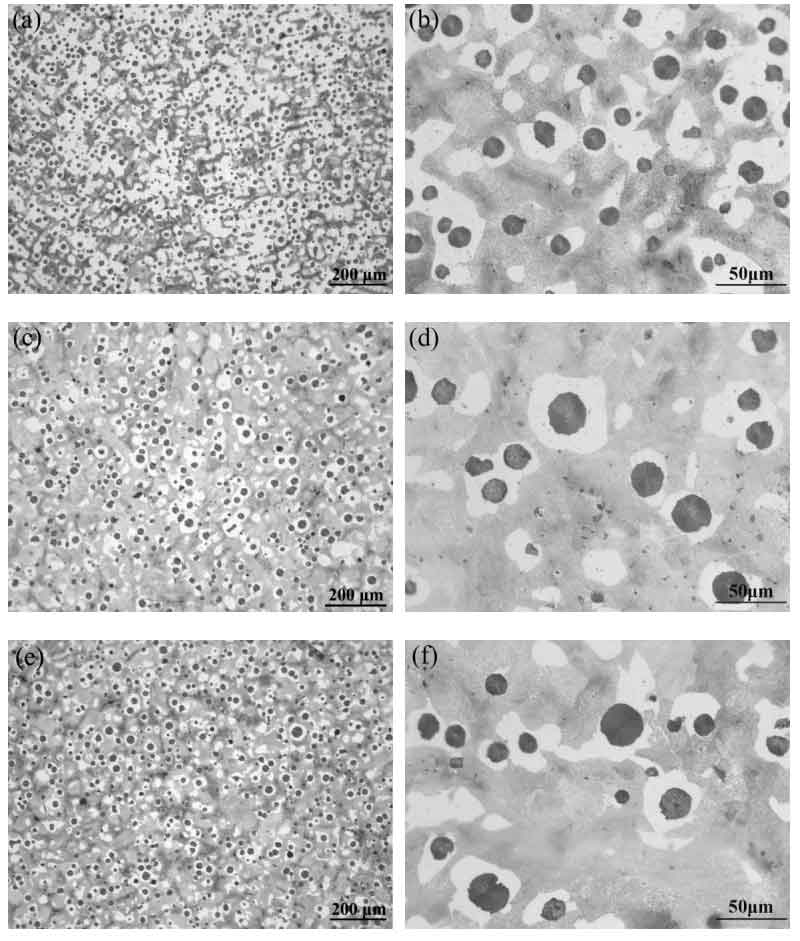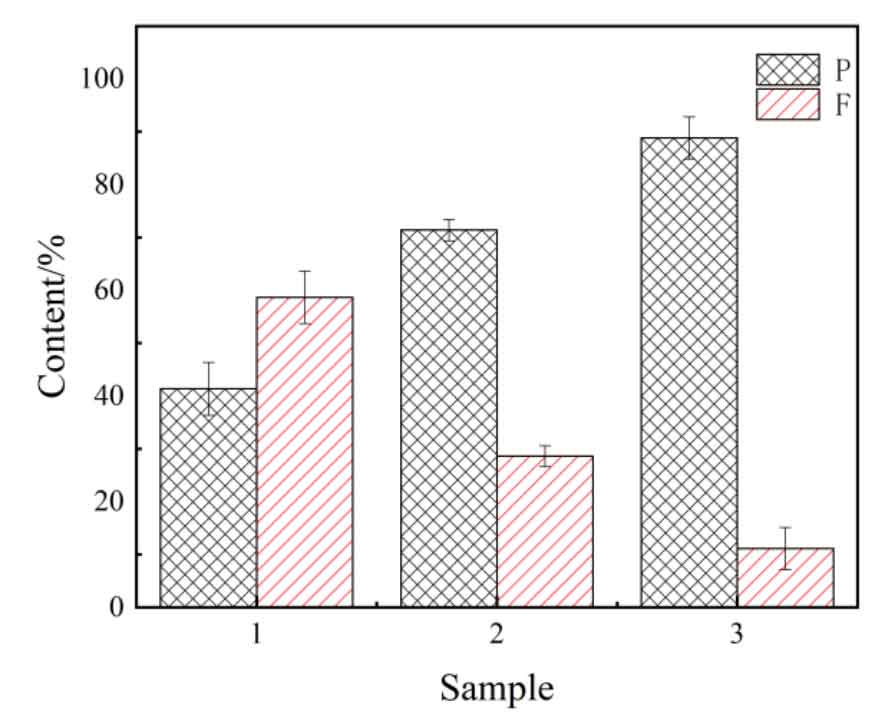The metallographic samples of nodular cast iron No. 1 ~ 3 nodular cast iron corroded by 4% nitric acid alcohol solution are magnified by 100 times and 500 times, as shown in Fig. 1 (a) ~ (f). The structure of nodular cast iron studied is composed of pearlite, ferrite and spherical graphite distributed on the matrix. In the photo, the white structure is ferrite and the dark structure except black graphite is pearlite.
Graphite balls can be regarded as cavities in the matrix of nodular cast iron [78]. The size, roundness and dispersion uniformity of graphite balls have a significant impact on the comprehensive properties of nodular cast iron and are important parameters to measure the quality of nodular cast iron. It can be seen from the figure that the graphite ball size of No. 1 nodular cast iron sample (Fig. 1 (a) and (b)) is relatively uniform. According to the statistics of iPP (Image Pro Plus) software, the graphite ball diameter size distribution range of this nodular cast iron sample is 0.007 ~ 0.031 mm, with a large number of graphite balls, which are evenly distributed in the middle of the ferrite matrix. When the content of other elements in the composition remains unchanged, the content of Mn increases to 0.44wt.% As shown in Fig. 1 (c) and (d), the number of graphite decreases significantly and the size of graphite ball increases, but the diameter distribution of graphite ball is uneven, and the size range is 0.007 ~ 0.033 mm. Increase the content of Cu to 0.45wt.% The number of graphite balls of No. 3 ductile iron sample (Fig. 1 (E) and (f)) is also lower than that of No. 1 ductile iron sample, the roundness of graphite is better, and the size distribution range of graphite balls is 0.007 ~ 0.037 mm.
The comparison shows that among the metallographic structures of the three groups of materials, the number of graphite balls of No. 1 nodular cast iron sample is the largest, and the size of graphite balls is small but uniform. Compared with No. 1, the number of graphite balls in No. 2 ductile iron sample is reduced and the size is increased, but the overall size distribution is uneven; In terms of spheroidization rate, No. 1 ductile iron sample is higher than No. 2 ductile iron sample, but slightly lower than No. 3 ductile iron sample.
Referring to GB / T 9441-2009 metallographic test standard of nodular cast iron, the number of graphite, size grade of graphite ball and spheroidization rate in multiple metallographic photos of different areas of No. 1 ~ 3 nodular cast iron samples are counted by IPP software, and the average value is calculated. The statistical results are shown in the table.
The matrix structure of nodular cast iron is an important factor to determine its mechanical properties. For ferrite pearlite based nodular cast iron, the change of the relative content of the two matrix structures will also affect the properties of the material. The specific performance is as follows: due to the relatively low carbon content of ferrite in the matrix, the ductility is good, but the strength is poor; The increase of pearlite will increase the strength and hardness of the material and reduce the impact toughness and elongation.
By observing the matrix structure in the metallographic photos of Fig. 1 (a) ~ (c), it can be found that the proportion of ferrite in the matrix structure of No. 1 ductile iron sample is high, which is about 58.7% of the total area of the matrix (as shown in Fig. 2), and is distributed in continuous sheets. When the Mn content increases from 0.28 wt.% to 0.44 wt.%, the ferrite content of No. 2 ductile iron sample decreases, accounting for about 28.6% of the total area of the matrix, and is evenly distributed in the form of “ox eye” structure around the graphite, and the pearlite structure in the matrix increases significantly. The pearlite content of No. 3 ductile iron sample increased significantly and the ferrite was further reduced to 11.2% when the Cu content was increased to 0.45 wt.%.
Through the above microstructure observation and discussion, comparing the metallographic structure of No. 1 nodular cast iron sample and No. 2 sample, it is found that when the content of Mn increases from 0.28 wt.% to 0.44 wt.%, the number of graphite balls in the structure decreases and the spheroidization rate decreases; At the same time, the content of pearlite in the matrix increased from 41.3% to 71.4%, which shows that Mn element can promote the formation of pearlite, but hinder the growth of graphite ball, which has also been confirmed in some previous studies.
Comparing the microstructure of No. 1 ductile iron sample and No. 3 sample, it is found that when the content of Cu increases from 0.3 wt.% to 0.45 wt.%, the number of graphite balls in the microstructure of ductile iron decreases, but the spheroidization rate increases slightly; At the same time, the content of pearlite in the matrix increased significantly to about 88.8%, indicating that the increase of Cu not only promotes graphitization, but also promotes the formation of pearlite. At the same time, because the ability of Cu to promote the formation of pearlite is about three times that of Mn, the pearlite content of sample 3 with the highest Cu content is the most in the three groups of ductile iron samples.



